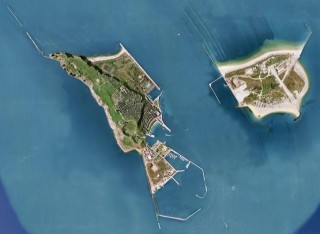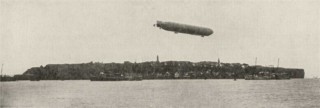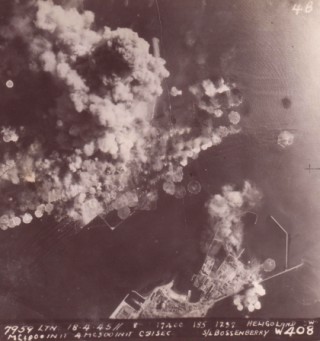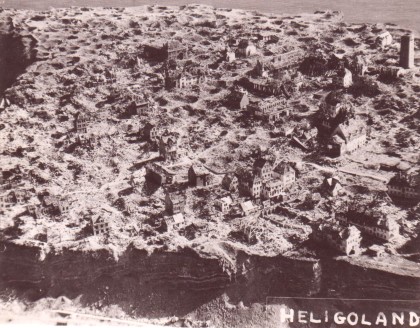Heligoland
| To neutralize German defences, Bomber Command launched a massive daylight attack on the Heligoland Naval Base and the airfield (a quarter of a mile due east) on the adjacent island of DŁne, 18 April 45. The attack force numbered 969 aircraft, with No 6 Group despatching 112 Halifaxes. For the nearly five hour mission, each No 426 Squadron aircraft carried nine 1000 pound and four 500 pound bombs. The Thunderbird bombers began taking off at 0952 hours and it took thirty-six minutes for all the squadron aircraft to launch, since they shared the departure slots with No 408 Squadron. The weather in the target area was clear with some scattered stratus cloud at 12000 feet. Visibility was excellent. Six waves of bombers attacked the islands between 1223 and 1346 hours. Twelve Mustang and ten Spitfire squadrons provided fighter cover for the operation. Meagre, but fairly accurate heavy flak, hit one aircraft that fell into the sea (a No 408 Squadron crew). |
The first Thunderbird aircraft bombed their objective, the intersection of the two runways on DŁne, at 1229 hours, with the remaining crews completing their runs within two minutes, from 17200 to 19000 feet. The crews delivered a concentrated attack, and could see several explosions and smoke rising to 6000 feet as they left the area. The Master Bomber was pleased with the progress of the raid, and in an emotional outburst called it, “Wizard bombing!” P/O A.H. Whipple and his crew in Halifax PN226/OW “H” had just completed their bombing run when a huge explosion struck their aircraft, the result of a 500 pound and 1000 pound bomb striking each other nearby. The crew was shaken up, but only the navigator, F/S D.W. Gaffray, was hit by a small piece of shrapnel. When they arrived back at Linton they made an emergency landing with the port tire flopping about. Between the pilot and engineer, with some especially skillful manipulation of throttles and flaps, the Halifax came in for an excellent landing, coming to rest in front of the control tower. An examination of the bomber revealed damage to the port and starboard main spars and more than a hundred small and large holes throughout the aircraft. For his actions getting the damaged Halifax and his crew home, P/O Whipple received the DFC. | |
A zeppelin prepares to dock at the DŁne airfield. | The raid left almost the entire area of the two islands covered by an extremely heavy concentration of craters. Most of the buildings had been destroyed, and the rest badly damaged. Both the runways on the airfield were rendered unserviceable. The attack also destroyed most of the gun positions and set ablaze a large underground oil storage facility. |
|
|


















































